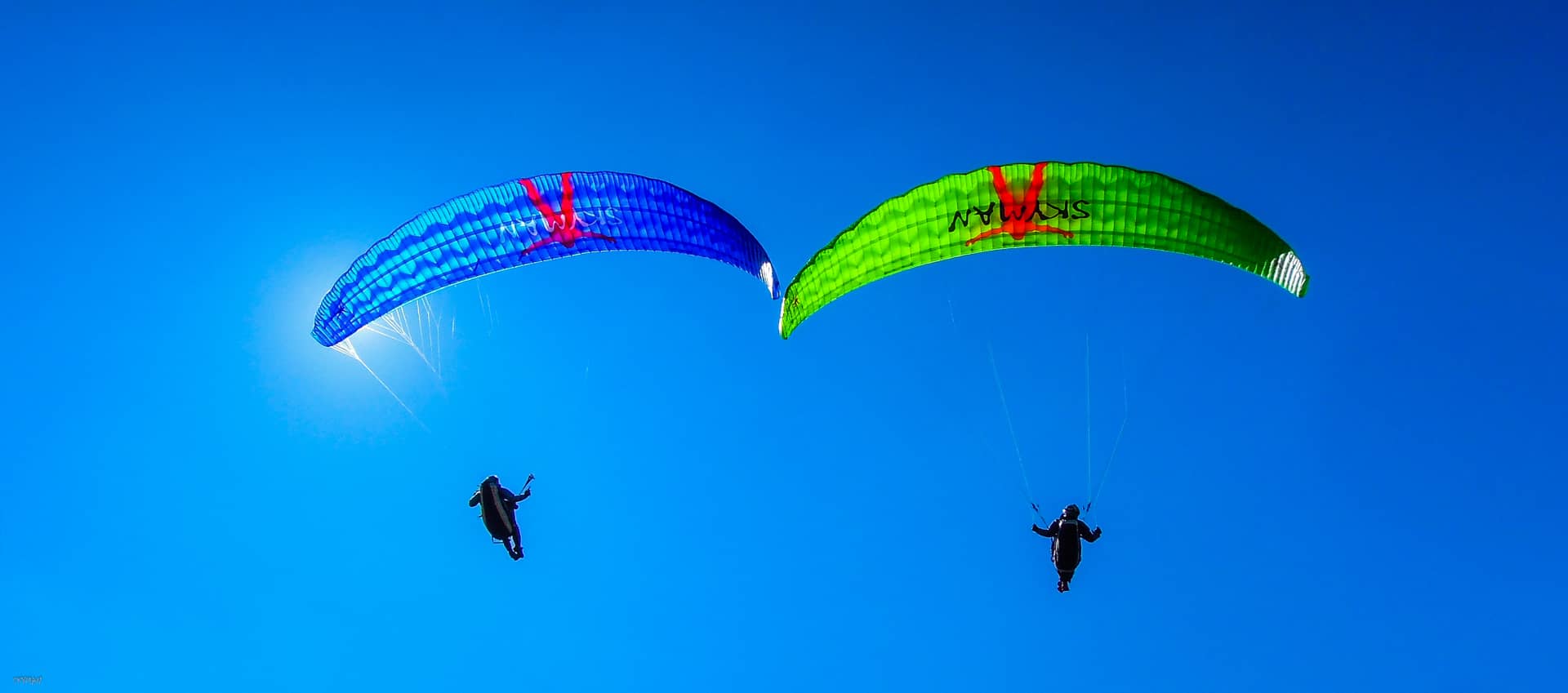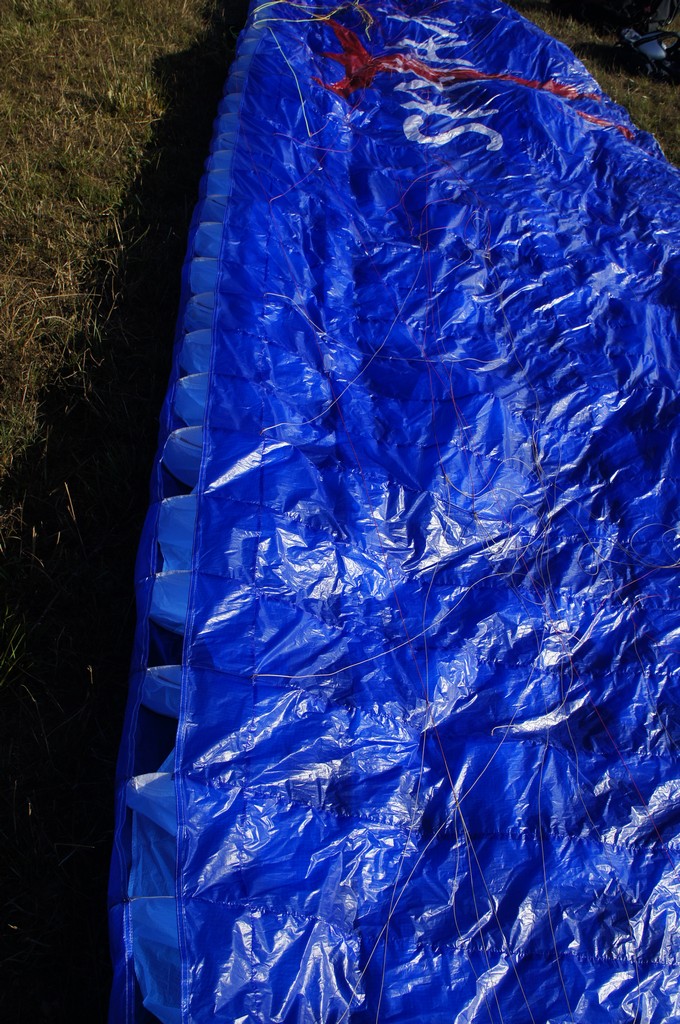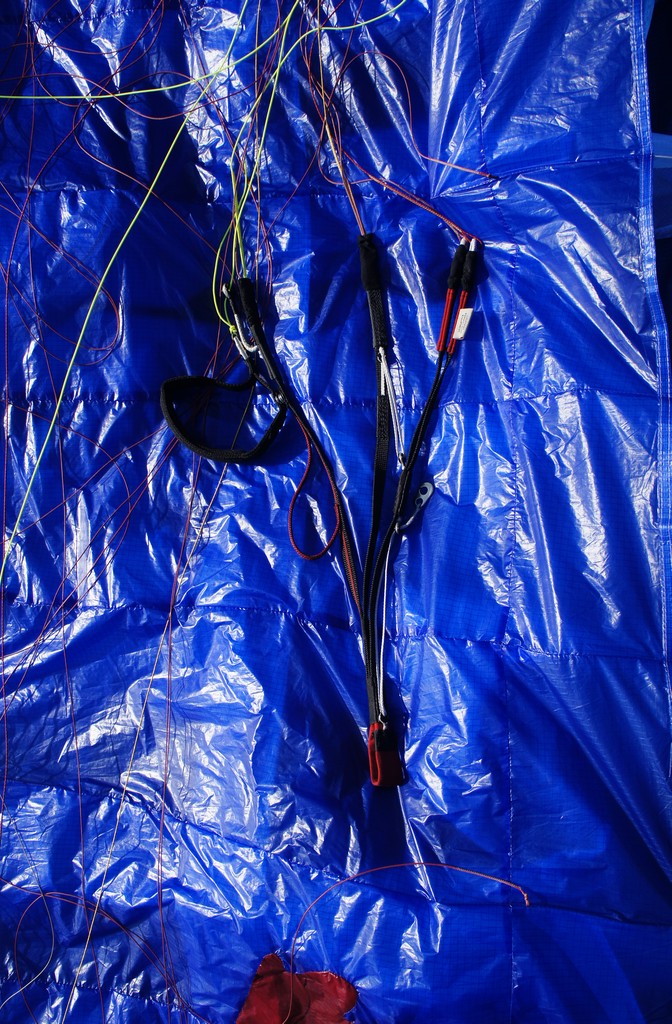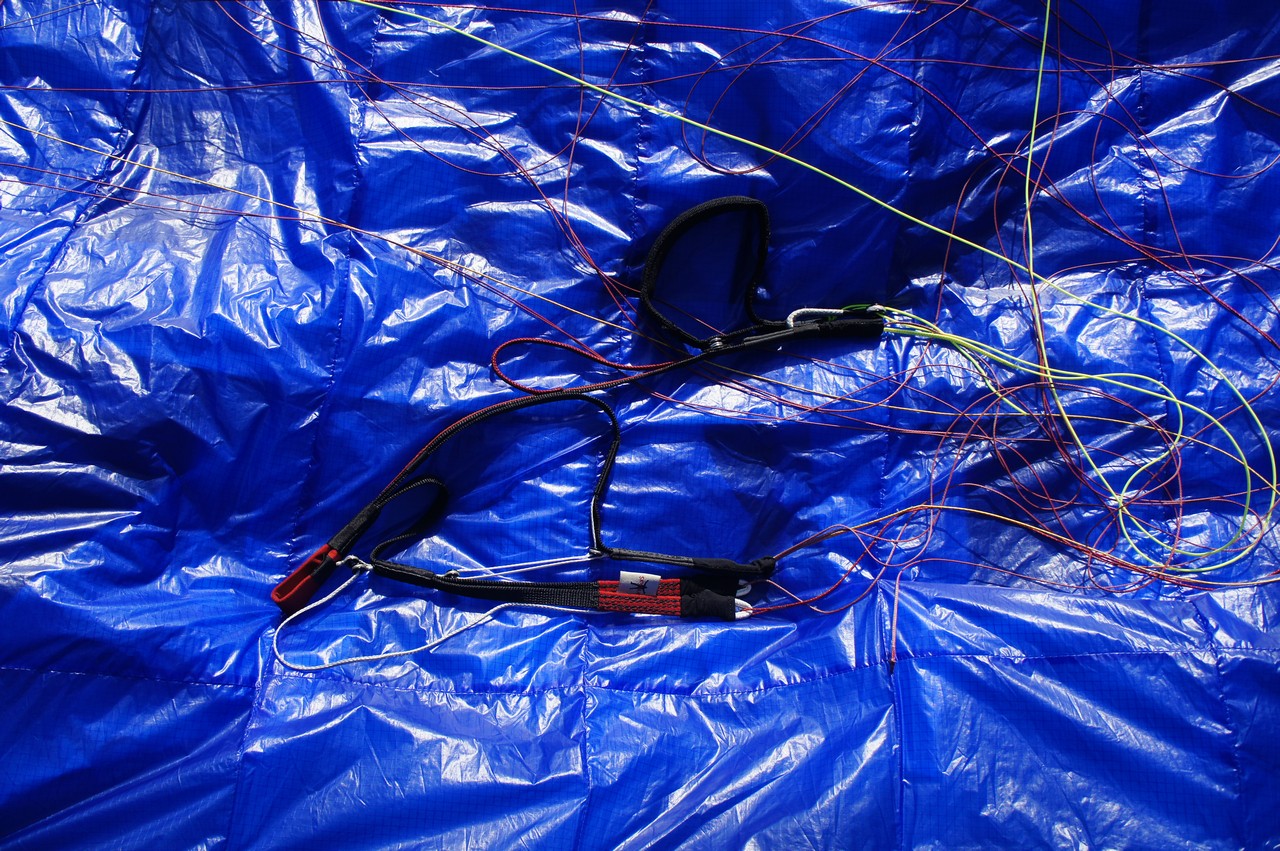Design
It is immediately clear that we are looking at an ultra lightweight product! You don't even need to take CrossAlps out of the concertina - it weighs suspiciously little both with the wing inside and on its own. The big inserts made of very light paraglider fabric with very generous perforations catch your eye at once. We open the concertina and the bright Indian sun begins to shine dazzlingly off the surface of the wing fabric. The fabric is amazingly thin and resiliently rubbery, you can't believe you can fly on THIS. The construction of the wing seems not revolutionary (well, minus the brave choice of materials). A reasonable elongation, not too few and not too many sections, moderate length and stiffness of the leading edge line... But you can wonder a little bit about the design of the loose ends. Instead of blocks in the guide of the brakes and gas pedal there are small and light rings made of ceramics. Getting ahead of myself, I would like to say that these rings will be associated with both positive and negative flight impressions. The ends themselves are made very intelligently - from narrow but powerful centimeter-long dyneema tape in a braid. Naturally, weightless softlinks instead of steel connectors. But they didn't save weight on the brackets handles - they are quite traditional, rather big, with a thick layer of neoprene and nice magnets. The slinging is expectedly flapless on all tiers. The slings are few and they don't tend to get tangled. The color design of the wing is very much to my liking. Personally I'm a little intimidated by the sprawling red man and the deliberately crooked Skyman lettering on the belly of the wing; however, taste and color...
Start
Unfortunately, I can't say anything good about the launch, as the Birch conditions didn't give me a chance to try it. The acquaintance with the wing started straight from the battle start in nearly the calm from the limited area and with a whole line of people waiting behind. Definitely not the kind of start where you can afford to slow down and make mistakes. Don't let me down, CrossAlps! And he certainly didn't let me down! Beautiful start. Like a super light glider, CrossAlps goes up to the flying position just with a thought. Few feared that the very low weight would make it overshoot on takeoff, but no, CrossAlps goes over head easily and smoothly, not trying to outrun the pilot. The load is good and fast, brakes are obeyed from the first acceleration. All in all, she is nothing but positive.
Flight
When flying in serious mountains, it is not so important how steep the flying machine is. Safety, easy start, maneuverability (as a wing's ability to gain in difficult and tough mountain streams), and finally, decent speed reserve (so as not to be accidentally "trapped" by the wind in some gorge) are of primary importance here. But the main thing for real mountain glider is of course the comfort and sense of reliability, without which, in my opinion, the serious mountain flying is impossible. It seems that creators of CrossAlps were guided by nearly the same set of criteria - from the first minutes of flight it was clear that CrossAlps was tuned just for real mountain flying, and this feeling became stronger when getting familiar with the glider.
Flying ability. Let me repeat - you don't need anything extraordinary from an alpine wing in terms of speed and quality, but this wing should not be slow at full gas pedal either. This is exactly how CrossAlps turned out. I was able to fly quite long crossings in calm high altitude air next to Ozone Delta 2 and Advance Sigma9, though not wing-to-wing, but more or less next to each other, at a couple of hundred meters distance. Yes, not too close, but I repeat - the air was very smooth and calm, it was not "boiling" with thermals, it was quite homogeneous in a large volume, so the comparison was quite fair. On the modes from balancing to about 50% of the gas pedal stroke, not a single wing showed a clear advantage in glide, all flew about the same. There was certainly a difference in speed, but it must be put down to the 10-kilogram overload. The speed increase on the first stage of gas pedal is classic ~10 km/h, and on the second stage CrossAlps adds more weight - about 14-16 km/h. Quite a decent figure, a bit even above the EN C class average. By the way, one not very pleasant peculiarity of the test subject turned out to be connected to the flight on gas pedal. Ceramics of gas pedal linkage under load have serious friction, and that is why the gas pedal is not only squeezed a little bit tightly, but it is not reset instantly after releasing a foot as it happens in case of block wiring. However, while discussing this nuance it turned out that when ordering CrossAlps you can choose between the ends with or without blocks in the gas pedal harness. I categorically recommend the blocks!
Our test wing didn't shine with its quality at maximal speed - but, I repeat, the mountain glider doesn't need it at all. On the average all three wings were going the same way. And here it's time to remember that the route consists not only of transitions, but also of sets, in which CrossAlps did not disappoint either. Even with 10-kilogram overload it was possible to convincingly "raise" in weak unreliable thermals, breaking the border of inversion. CrossAlps is not prone to "crumble", even in quite compact spirals it showed quite a small drop.
Maneuverability. Well and properly tuned again for mountain flying. I.e. not too high, but plenty enough for confident handling of any thermal flows. If we compare CrossAlps with its "schoolmates", then in terms of sharpness of reaction on controlling it lags far behind Skywalk Cayenne5, which is a confident leader in this aspect, but somewhat surpasses such quiet products as ParAAvis Dream and Axis Vega 5. However, you don't need too much sharpness in the mountains - it's the accuracy of control response that matters, and KrossAlps is all right with it. It follows your hand calmly but confidently enough, reacts without any noticeable lag. In real mountain streams I have never had any difficulties - the wing's reactions to control have always been calm, clear, obvious, it did not take any getting used to at all. And here it is time to remember again about the ceramic rings in the brake wiring. Unlike the rings in the gas pedal harness, this option was more than appropriate for the brakes. You couldn't feel any friction, and there were no rattling or squeaking noises that distorted the view of the load on the brakes. I liked it very much! I also like the way the CrossAlps handles maneuvers that are more energetic than thermal spirals. The wings are convincing and it's easy to control the wing even on big rolls. Steep spirals are in the same vein: smooth, well-controlled acceleration and equally smooth exit.
Comfortable and informative. I don't hesitate to repeat - for a mountain glider the right balance of these mutually contradictory characteristics is really important. You should have a lot of comfort, very much - but informative performance should not suffer. In this respect the CrossAlps is definitely a success. The experimenter behaves quite predictably even in the weather fraught with regular cramps, and its behavior at that is deprived of any abruptness. But there is also quite a lot of information coming to the pilot. As is often the case with calm wings, it is mostly airspeed variations. In pitch, the machine is heavily damped, so you can't expect it to make any extra movements, and CrossAlps is not inclined to go back and forth in any way. There is not much more information about the roll. But it is quite informative about the load on the brakes, and you can navigate very well with the load on the tips. All this is absolutely enough to feel even pretty tricky flows without losing that pleasant feeling of comfort, which helps so much in the mountains. However, I have to add a small fly in the ointment. Our subject is prone to "sticking" of "ear" on "fighting" compounds, requiring pumping of the bracket for opening. It seems to be a trifle, but it unpleasantly distracts and reduces the sense of comfort.
Dynamics and power capacity. In general, CrossAlps is quite a sedate machine, i.e. you will not wait for great dynamics from it. But it is able to store quite a lot of energy. Transitions of speed to high speed and vice versa are done with pleasant laziness, which is typical for calm, comfortable wings. But the smoothness of the wing should not deceive - rough and inaccurate piloting on wingovers or steep turns can lead to all sorts of unpleasant tricks like sharp folding or powerful 'slide'. The test pilot landed well and convincingly with overdrive, but overloading could have had an effect.
Dangerous flight modes
Asymmetric stacking
Interesting and ambiguous behavior with pros and cons. Causing addition is physically quite difficult, the leading edge is heavily loaded. The addition does not want to spread further than 10-15% of the chord, and when the A-series is released, it opens instantly, so quickly that the device practically does not have time to respond to the addition. Heading deviation, oblique peck and loss of height, respectively, are ridiculous. It is very reminiscent of the behavior of Cayenne the Fifth ... if not for one unpleasant nuance. An “ear” that is guaranteed to “stick” on every collapse and requires vigorous pumping to open. Both in the "combat" and in the test additions, the unopened "ear" had almost no effect on the behavior of the wing, but the need to open the "ear" manually still does not please. It’s good that there is no noticeable trend towards “ties” ... In general, excellent with a minus.
Asymmetric collapse at 50% throttle travel
It's like I'm testing another device! The constitution develops quite deeply along the chord - by about 40 percent, the device cheerfully jumps into an oblique peck with an amplitude of up to 45 degrees, after which it opens just as cheerfully, with a pop. Heading deviation - within 90-100 degrees, loss of height - no more than 20 meters. Everything would be fine, but the problem with the sticky "ear", alas, does not go away. More precisely, how lucky - at especially sharp openings, the “ear” can be knocked out to the working position, but I can’t guarantee such behavior. Excellent with a minus.
Front fold
Different from asymmetric symmetry ;), as well as a non-100% probability of sticking "ears". It is just as difficult to fold, the addition also does not develop deep along the chord and is just as instantly revealed. Loss of altitude - less than 10 meters, pitch dive is almost absent. Excellent with a minus.
Thermal Spiral Explosion
Original, not like everyone else. Almost the entire console is involved in the stall, and there is no clear boundary between the stall and the negative spiral. Do it carefully! However, it is not so easy to miss the regime - a pronounced drop in the load on the inner arm helps out and, even more pronounced, a very noticeable acceleration of rotation at the beginning of a breakdown. The toggle travel before stalling is large enough, it is unlikely that it will be possible to accidentally disrupt it. In general, a four.
Fast descent modes
Ears
Problem! They add up well and even very well (we have already seen this in the study of additions), thoroughly “stick” ... and slow down the apparatus very much. The airspeed in the mode drops very noticeably, by sensations - by several kilometers per hour. Immediately there is a desire from the heart to squeeze the accelerator. We suppress this sensation and begin to open our “ears”. Releasing the "ear" slings does not give the expected effect. Energetic transshipment from side to side in the suspension - oddly enough, too. The most unpleasant option remains - to open with toggles. And it’s better to do it one by one: first one “ear”, wait a bit, pick up speed, then the second “ear”. The desire to symmetrically "squeeze" for the simultaneous opening of both "ears" does not arise at all - and without that, the airspeed on the "ears" drops noticeably, threatening to enter stall modes. It is difficult to make an assessment: the efficiency of the "ears" is good (the decrease is to about -3 m / s), but approaching parachuting does not create delight. Four with a fat minus, something like that.
Ears + Accelerator
Better already. And the efficiency is expected to grow, and the speed ceases to be threateningly low. In principle, you can even open your "ears" without releasing the accelerator. Rating - good with a plus.
Steep spiral
Great. No features were identified, it is simple and clear, spiral neutrality, if it appears, then with a very large decrease.
Conclusions
CrossAlps is a vivid example of a lightweight mountain wing that is rarely seen on the Russian market, and even an EN C class. Volatility with maneuverability, however, also does not disappoint at all. There are nice features important for the mountain wing, like a very easy start. And everything would be fine - but the impression is somewhat spoiled by great efforts in the accelerator wiring (which is “treated” by ordering a device with rollers, and not rings in the accelerator wiring) and regular sticking of the “ears” (which, alas, is “treated” only by their no less regular shaking). And if there is a desire to use the “ears” as a means of rapid descent, then it is categorically desirable to combine the “ears” with an accelerator, otherwise there is a great risk of getting one of the stall modes, especially in the rain (I observed such a picture in Chegem). The traditional question "for the mountains or for the plains" in this case is convincingly resolved in favor of the mountains. The device was clearly and purposefully brought under mountain flights, this is felt literally in all aspects of its behavior and character. But this does not mean that the plain is contraindicated for this wing. No, it will also be able to show itself on the plain - but still, the native element of CrossAlps is the mountains, where this device can reveal its capabilities to 146%. For the plains, something more nimble, more sensitive and even sharp is better - for example, Cayenne5. And CrossAlps is a real “workhorse”, which, perhaps, does not impress with super-maneuverability and super-volatility, but it allows you to fly safely even in very difficult high-altitude conditions without straining. The minimum required flight time is 50-60 hours.
Pros
- Very comfortable, calm character
- High passive safety, especially for collapses
- Good performance
Cons
- "Ears" sticky after almost every fold
- The "ears" without using the accelerator bring the device too close to stall modes









